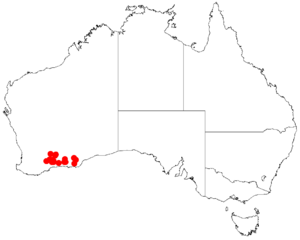Acacia nivea facts for kids
Acacia nivea is a special kind of shrub found only in the southwestern part of Western Australia. It belongs to the large Acacia family, which is also known as wattles. This plant is unique because it's endemic to this area, meaning it doesn't naturally grow anywhere else in the world!
Quick facts for kids Acacia nivea |
|
|---|---|
| Scientific classification | |
| Genus: |
Acacia
|
| Species: |
nivea
|
 |
|
| Occurrence data from AVH | |
Contents
What Does Acacia nivea Look Like?
This low, spreading shrub usually grows to be about 0.4 to 1 meter (1.3 to 3.3 feet) tall. It often forms a thick, dome-shaped bush. Its small branches are round, a bit hairy, and sticky with resin.
Leaves and Flowers
Like most Acacia plants, Acacia nivea doesn't have true leaves. Instead, it has special flattened stems called phyllodes. These phyllodes are smooth, evergreen, and also sticky with resin. They stand upright or curve slightly. Each one is about 1 to 2 centimeters (0.4 to 0.8 inches) long. They are quite thin, about 0.8 to 1.2 millimeters wide, and have 12 to 16 fine, slightly raised lines.
The plant blooms from July to September, showing off its bright yellow flowers. The flowers grow in simple, round clusters. These clusters are found in pairs where the phyllodes meet the stem, called the axil. Each flower head is about 2.5 to 3 millimeters (0.1 inches) across. It holds 9 to 12 golden-colored flowers.
Seed Pods
After the flowers bloom, thin, leathery seed pods start to form. These pods are long and straight, or sometimes slightly curved. They have bumps over each seed, alternating from one side to the other. The pods are about 3 to 3.5 centimeters (1.2 to 1.4 inches) long and 3 millimeters (0.1 inches) wide. Inside, the seeds are neatly lined up lengthwise.
Where Does Acacia nivea Grow?
Acacia nivea is found in specific parts of Western Australia. It grows in the southern Wheatbelt and Goldfields-Esperance regions. You can often find it on gently rolling plains. It prefers soils that are a mix of clay and sand, or sandy-loam, or just sandy soils.
Its Home Environment
This plant is spread out in different spots, not in one continuous area. You can find it from around Lake King in the northwest to Munglinup in the southwest. Some groups also extend further east to Grass Patch, Mount Andrew, and Ponier Rock. It usually grows as part of low, open shrublands or tall mallee shrublands. It can also be found in low, open woodlands.
How Scientists Classify Acacia nivea
Acacia nivea is part of a special group of wattles called the Acacia dielsii group. This means it shares many features with other plants in that group. Scientists R.S.Cowan and Maslin officially named and described this species.

